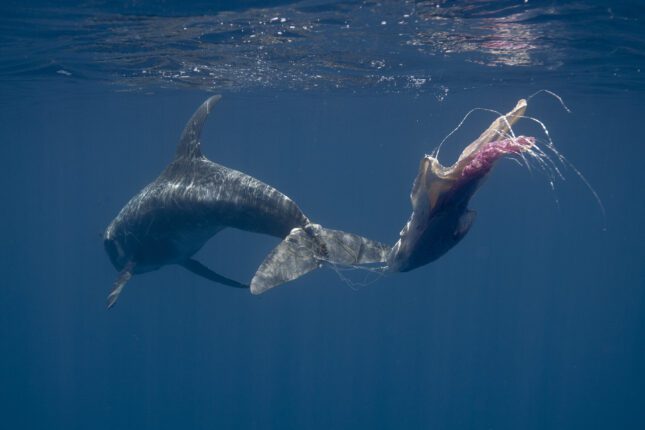-
Microplastics are Sickening and Killing Wildlife, Disrupting Earth Systems
November 26, 2024 By Sharon Guynup
This article, by Sharon Guynup, originally appeared on Mongabay.
Bottlenose dolphins leapt and torpedoed through the shallow turquoise waters off Florida’s Sarasota Bay. Then, a research team moved in, quickly corralling the small pod in a large net.
With the speed of a race car pit crew, veterinarians, biologists and their assistants examined the animals, checking vital signs while taking skin, blood and other samples. They held a petri dish over each dolphin’s blowhole until it exhaled, with an intensity similar to a human cough. Then, they rolled up the net and the dolphins swam off unharmed. A pod in Louisiana’s Barataria Bay was similarly tested.
Generations of dolphins have been part of this ongoing dolphin health study, which has been run by the Sarasota Dolphin Research Program since 1970. It tracks populations and individuals and also looks for health issues related to pollutants in the marine environment.
In the lab, scientists discovered that all 11 of the dolphins had breathed out microplastic fibers, shed from synthetic clothing, says Leslie B. Hart, associate professor at the College of Charleston and an author on this research. The fibers resembled those found in human lungs in previous studies, proving that dolphins, like us, are breathing plastic. In people, microplastic has been linked to poor lung function and possible lung disease.
An earlier collaboration linked phthalates circulating in the dolphins’ blood to alterations in their thyroid hormone levels — an effect also found in humans that can impact nearly every organ in the body. Phthalates, toxic chemicals found in flexible plastics, readily leach into the environment. The full effects on marine mammals remain unknown.
Continue reading on Mongabay here.
Sharon Guynup is a Global Fellow with The Wilson Center’s Environmental Change and Security and China Environment Programs. She is also a National Geographic Explorer. Much of her work on environmental issues focuses on wildlife, ecosystems and the threats they face.
Sources: Heliyon, Journal of Hazardous Studies, MDPI, PLOS ONE, Sarasota Dolphin Research Program
Photo credit: Rissos dolphin (Grampus griseus) entangles in fishing line and plastic bags, Indian Ocean, courtesy of Andrew Sutton/Shutterstock.com.
 A Publication of the Stimson Center.
A Publication of the Stimson Center.






